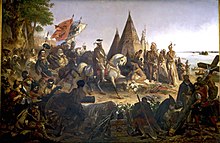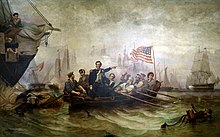William Henry Powell
George William Henry Powell (* 14. Februar 1823 in New York City; † 6. Oktober 1879 ebenda) war ein US-amerikanischer Historien- und Porträtmaler.
Leben

Powell, von Geburt New Yorker, wuchs ab dem siebten Lebensjahr in Cincinnati, Ohio, auf. 1837 kehrte er nach New York City zurück und studierte dort Malerei bei Henry Inman. 1844 unternahm er eine Studienreise nach Frankreich und Italien (Florenz und Rom). Ferner ist ein Studienaufenthalt in Düsseldorf dokumentiert.[1][2] Powell war Mitglied der National Academy of Design.
1847 erhielt er vom Kongress der Vereinigten Staaten den Auftrag, für die Rotunde des Kapitols das letzte freie Feld mit einem Historiengemälde auszustatten. Er wählte dafür das Motiv Discovery of the Mississippi by De Soto A.D. 1541 (Die Entdeckung des Mississippi durch Hernando de Soto im Jahre 1541), das bei Fertigstellung im Jahr 1853 ein großer Erfolg war und das zu einem Folgeauftrag des Staates Ohio für dessen State House führte. Diese Auftragsarbeit führte er in Gestalt des Historienbildes Perry’s Victory on Lake Erie (Der Sieg Oliver Hazard Perrys am Eriesee) von 1857 bis 1865 in seinem New Yorker Atelier in deutlicher Anlehnung an Emanuel Leutzes Gemälde Washington Crossing the Delaware aus, welches 1851 und 1853 in New York City ausgestellt war. Aus diesem Bild wiederum resultierte am 2. März 1865 auf Empfehlung des United States Congress Joint Committee on the Library ein Folgeauftrag des Kongresses, für das Treppenhaus des Senatsflügels des Kapitols ein Bild zu malen, das „einen Seesieg illustriert“. So entstand bis 1873 – als vergrößerte Version des Bildes im State House von Ohio – das Gemälde Battle of Lake Erie (Die Schlacht auf dem Eriesee).[3]
Werke (Auswahl)

- Dr. William Smith, Porträt, um 1841, Cincinnati Art Museum
- The Brigand’s Portrait, 1846
- Discovery of the Mississippi bei De Soto A.D. 1541 (Die Entdeckung des Mississippi durch Hernando de Soto im Jahre 1541), 1847–1853, Rotunde des Kapitols in Washington, D.C.
- Selbstporträt, 1855
- Perry’s Victory on Lake Erie (Der Sieg Oliver Hazard Perrys am Eriesee), 1857–1865, Ohio State House, Columbus
- Robert Anderson, Porträt, 1861[4]
- Battle of Lake Erie (Die Schlacht auf dem Eriesee), 1865–1873, Nordflügel des Kapitols[5]
- The Twenty-day Siege of the Mexican City of Veracruz in March 1847 (Die zwanzigtägige Belagerung von Veracruz im März 1847), 1867
- Battle of Buena Vista (Die Schlacht von Buena Vista)
Literatur
- William Henry Powell. In: David Bernard Dearinger (Hrsg.): Paintings and Sculpture in the National Academy of Design. Band I (1826–1925), Hudson Hills Press, New York und Manchester, 2004, S. 449 (Google Books)
- Michael J. Devine: The Historical Paintings of William Henry Powell. In: Ohio History Journal, Band 89, Nr. 1 (1980), S. 65–77
- Henry T. Tuckerman: Book of the Artists: American Artist Life Comprising Biographical and Critical Sketches of American Artists. James F. Carr, New York 1867 (Nachdruck 1966), S. 458 f.
- William Henry Powell. In: Andrew Oliver: Portraits of John Quincy Adams and His Wife. The Belknap Press of Harvard University Press, Cambridge/Massachusetts 1970, S. 273 (Google Books)
Weblinks
Einzelnachweise
- ↑ Richard Muther: Geschichte der Malerei im XIX. Jahrhundert. Dritter Band, G. Hirth’s Kunstverlag, München 1894, S. 370 (Nachdruck: Salzwasser Verlag, Paderborn, Google Books)
- ↑ Bettina Baumgärtel, Sabine Schroyen, Lydia Immerheiser, Sabine Teichgröb: Verzeichnis der ausländischen Künstler und Künstlerinnen. Nationalität, Aufenthalt und Studium in Düsseldorf. In: Bettina Baumgärtel (Hrsg.): Die Düsseldorfer Malerschule und ihre internationale Ausstrahlung 1819–1918. Michael Imhof Verlag, Petersberg 2011, ISBN 978-3-86568-702-9, Band 1, S. 438
- ↑ The Battle of Lake Erie. In: Catalogue of Fine Art, S. 34 ff. (PDF)
- ↑ Robert Anderson, Webseite im Portal www1.nyc.gov, abgerufen am 12. März 2017
- ↑ Battle of Lake Erie, Webseite im Portal senate.gov, abgerufen am 12. März 2017
| Personendaten | |
|---|---|
| NAME | Powell, William Henry |
| ALTERNATIVNAMEN | Powell, George William Henry (vollständiger Name) |
| KURZBESCHREIBUNG | US-amerikanischer Historien- und Porträtmaler |
| GEBURTSDATUM | 14. Februar 1823 |
| GEBURTSORT | New York City |
| STERBEDATUM | 6. Oktober 1879 |
| STERBEORT | New York City |
Auf dieser Seite verwendete Medien
In 1865, artist William Henry Powell painted Perry's Victory on Lake Erie, which now hangs in the Ohio Statehouse. Eight years later, he created this larger version in a temporary studio in the U.S. Capitol. The work depicts the moment when Perry made his way from the Lawrence to the Niagara. Powell used actual sailors as models for the unknown oarsmen, and noted the diversity of Perry's crew by including an African-American, seated toward the right. The frame features the name and date of the battle beneath the frame.
William H. Powell was the last artist to be commissioned by the Congress for a painting in the Rotunda. His dramatic and brilliantly colored canvas shows Spanish conqueror and explorer Hernando DeSoto, riding a white horse, the first European to view the Mississippi River, in 1541. As De Soto and his troops approach, the Native Americans in front of their tepees watch, and a chief holds out a peace pipe. In the foreground is a jumble of weapons and soldiers, suggesting the attack they had suffered shortly before. To the right, a monk prays as a crucifix is set in the ground.
Powell (1823–1879) was born in New York and raised in Ohio. He studied art in Italy and worked on the painting in Paris. He also painted The Battle of Lake Erie, which hangs in the east Senate Grand Staircase in the Capitol.



